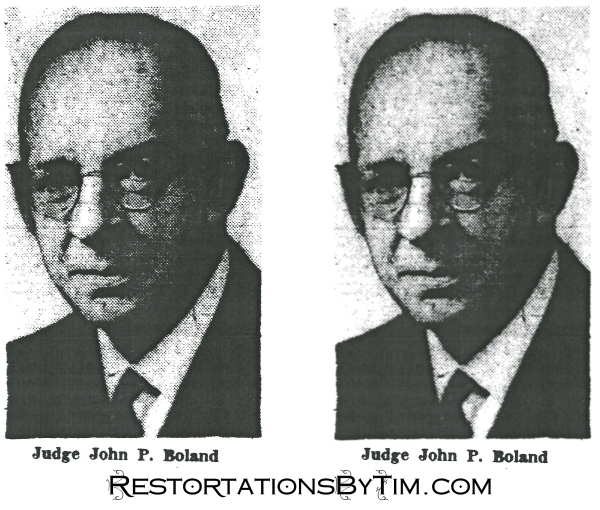
Maybe I’m front-loading my list with family superstars whom I truly admire. I think you’ll begin to see, however, that no story is too small, as Amy Johnson Crow will remind us. To the contrary, I think the heroism of my everyday ancestors will reveal itself once it is properly showcased beside the legends. All stories are big, in a way.
This week’s legend is Philadelphia Judge John P. Boland, a cousin of my paternal grandfather’s father. John’s uncle, John C. Graham, was my great-great-grandfather going straight up the paternal line. Where the immigration records of John C. Graham and his family ought to be sits a persistently gaping hole in my research. I have not yet found the ship’s manifests of my own namesake. According to the 1900 Census, John C. Graham, of County Antrim, Ireland, arrived on these shores in 1891. His older sister, Bridget Graham, arrived here six years earlier, in 1885. She married Michael Boland, of County Clare, in about 1895, again according to the census. That marriage record, too, seems to have evaded capture, as has the civil birth record of their first son, John P. Boland, who was born in April of 1896. I’ll have to have another look for those records. Or have I done that already? Don’t be like me, kids. Document your research!
John P. Boland would eventually have five brothers. One of his sisters-in-law, Peg, would write of their youth that the Bolands “came from Kensington, a tough mill section of that city,” and that the Boland boys “spent much of their free time playing in the streets and dodging trolley cars that ran noisily past both sides of the row house they lived in.” That row house was at 2100 E. Susquehanna Avenue, and a strange, green box of a building occupies the site today. Peg went on to mention that the Boland family set a record at Roman Catholic High School when all six Boland brothers graduated from that place. John P. graduated in from there in 1914. Shortly thereafter, he served in World War I as a sergeant with the American Expeditionary Forces.
My fascination with John P. Boland begins upon his return home, when he enrolled in Temple University’s School of Law, and graduate from there in 1921. I, myself, have been through law school. Although I haven’t yet made a career of it, I still enjoy the study very much, and I intend have another go at making that work at some point in the foreseeable future. Before I “met” John, however, I thought I was the only person in my entire family to pursue a legal career. Not so. There is a precedent in John Boland.
Upon his admittance to the bar, John found work at the law firm of Charles F. Kelley. When Mr. Kelley became Philadelphia’s District Attorney, he named John as his assistant. John held that position through 1941, when he was elected Register of Wills, a position that he would hold for two terms, through 1948. Being Register of Wills holds another special significance for me, as a genealogical researcher. When I go to Philadelphia City Hall to research old wills, most of them are either on microfilm or microfiche. The Register of Wills office still has the old administration books, seemingly neglected in a partially covered bookcase. John Boland’s name appears on the spines of each of the several volumes of administrations that passed through that office while he was the register. His signature appears on each document inside.
I’d like to find a way to get a photograph of that whole bookshelf, with each of the books bearing the name John P. Boland, for my family tree collection. Photography is prohibited in the room though. Perhaps I could get a special, supervised dispensation if I ask the right people, but I don’t think the ordinary staff is down with those sorts of shenanigans.
But enough about me. John’s story continues. He was appointed to the bench as Judge John P. Boland in 1949. All the while, he was active in several legal and fraternal organizations, including the Thomas More Society for Catholic lawyers, and the Caveat Club, which Gerard St. John described as follows, writing for The Philadelphia Lawyer:
It began with a small group of Irish Catholic lawyers who regularly challenged each others’ statements. It was the proponent’s obligation to prove the accuracy of the disputed matter. After losing a few challenges-and enduring the jibes that went with the losses-speakers were advised to “beware” or “caveat,” lest the experience be repeated. Thus, the name “Caveat Club” came into being. From that humble beginning, the group expanded its membership beyond Irish Catholics. The Caveat Club brought a new weapon to bear upon the established leadership of the Bar Association: humor. It was a quality that Peter F. Hagan, James P. Crumlish, Joseph S. Lord III, John P. Boland, Nochem Winnet, Charles Klein and many other Philadelphia lawyers had in abundance. Eventually the energy of the club was focused on the Bar Association elections, and the Old Philadelphia hold on the office of Chancellor was broken. The Caveat Club’s unofficial “chairman,” Walter B. Gibbons, served as Chancellor in 1943 and 1944, the first non-establishment Chancellor of the Philadelphia Bar Association.
John’s sister-in-law, Peg, described John as “A spectacled, soft-spoken man, John looked like a typical college professor, but he was a power in Republican politics in the city.” The spectacles are evident in the photo above. I’ll let you decide for yourselves whether he looks like a “typical college professor”.
Like many of the legends on my tree, John’s life met an early end. John suffered from hypertension. He died on April 15, 1952, at the age of 56, following a surgical procedure intended to correct the problem. He is buried in Holy Sepulchre Cemetery, just northwest of Philadelphia, near many other members of my paternal grandfather’s family, including his parents, his paternal grandparents, his brother, and his wife, my grandmother, who passed away in 2008.
What’s next for John P. Boland research? Of course, I would like to compile a list of John P. Boland’s most important cases. Finding his descendants is also a priority. They will surely have more insights and information. John had two children that I know of with his wife, the former Beatrice Murphy.
I don’t yet have any good proper pictures of John. The photograph above is from his obituary in the Philadelphia Evening Bulletin. It’s not a proper restoration, but I thought I’d use it to show you this simple trick for improving your on-screen genealogy experience: Images scanned directly from newsprint often render poorly on computer screens. This is because your computer has trouble re-sizing and fitting together the individual dots that make up the image. You can solve this problem with a little Gaussian Blur. When you take the edge off of the dots the whole image becomes more a more continuous grayscale that appears cleaner on screen. Give it a try! Here is the command in GIMP:
Bibliography: Most of this post was adapted from John’s obituary in the Philadelphia Inquirer on April 16, 1952, and in the Evening Bulletin on April 15, 1952. Other sources mentioned or linked in the article.

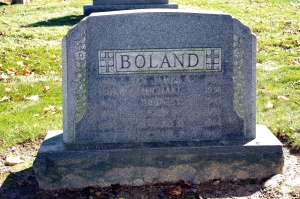
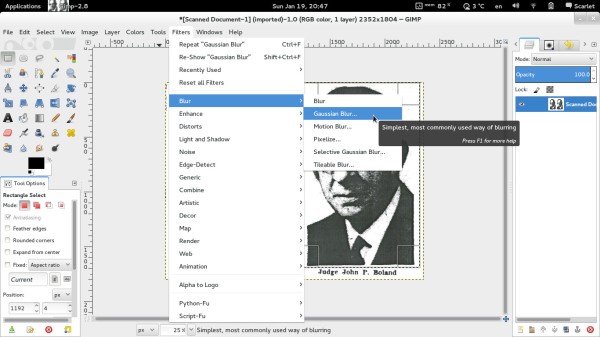
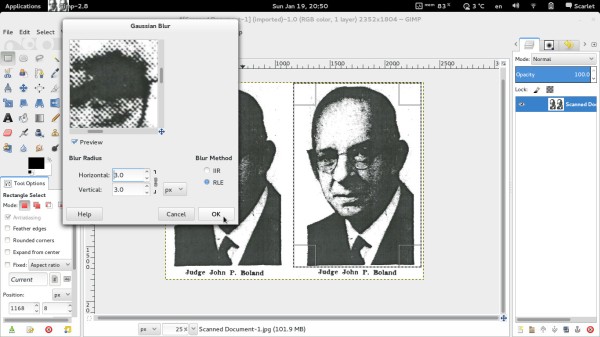




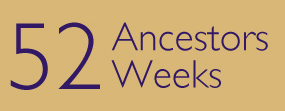
Leave a Reply